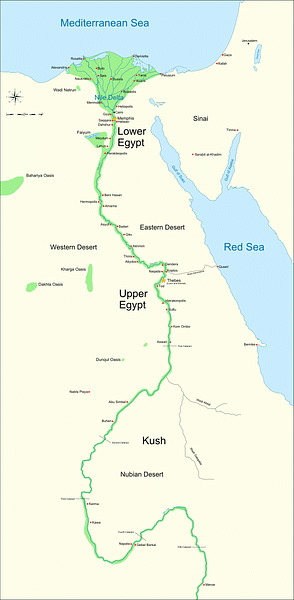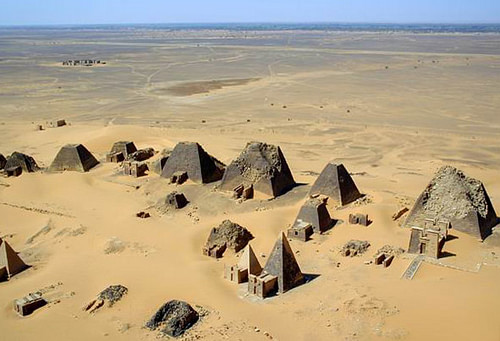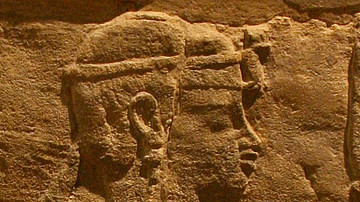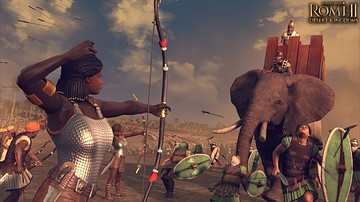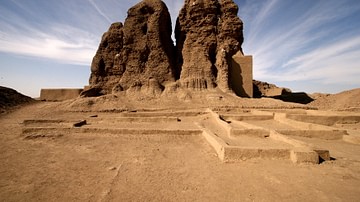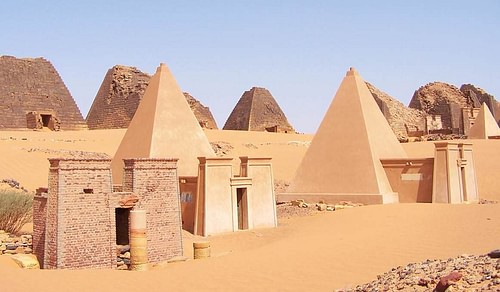
King Ergamenes (also known as King Arkamani I, r. 295-275 BCE) was the greatest king of the city of Meroe, Kingdom of Kush (located in modern-day Sudan) who broke free from Egyptian dominance to help direct a wholly distinct culture. The city of Meroe is cited by many ancient writers (Herodotus among them) as an almost fabled city of wealth and mystery, and scholars credit Ergamenes for establishing the culture which fostered such prosperity and lay the groundwork for later Meroitic kings and queens to build upon.
His relationship with the Pharaoh Ptolemy II Philadelphus (r. 285-246 BCE) is the earliest documented case of political cooperation between Meroe and the Ptolemaic Dynasty of Egypt. According to the historian Robert Steven Bianchi, Ergamenes was closely tied to the Egyptian throne and "possessed a titulary composed of five royal names on the model of traditional ancient Egyptian pharaohs" including his throne name Khnum-Ib-Re. He is most famous as the ruler who broke with the long-standing tradition of religious authority superceding the secular authority of the king.
Ergamenes and the Priests of Amun
According to the historian Diodorus Siculus (1st century BCE), in the time before the reign of King Ergamenes it had been the custom for the high priests of the god Amun to decide who became king and to set the duration of the king's reign. As the health of the king was tied to the fertility of the land, the priests had the power to determine if the sitting king was no longer fit to rule. If they deemed him unfit, they would send a message to the king, understood to be from the god Amun himself, advising him that the time of his rule on earth was completed and that he must die.
This tradition had been instituted at the city of Napata, which had been the capital of the Kingdom of Kush until it was destroyed c. 590 BCE by the Egyptian pharaoh Psammeticus II (595-589 BCE). Napata's culture had been significantly influenced by that of Egypt and the priests of Amun in the city had acquired the same level of power and influence as the ancient priests of the god in Egypt. In the same way that Amun in Egypt was thought to be able to speak directly to his priests, so was it believed he did in Kush. The kings of Kush, therefore, had always obeyed the divine orders and had taken their own lives for the supposed good of the people. However, Diodorus continues:
[Ergamenes], who had received instruction in Greek philosophy, was the first to disdain this command. With the determination worthy of a king he came with an armed force to the forbidden place where the golden temple of the Aithiopians was situated and slaughtered all the priests, abolished this tradition, and instituted practices at his own discretion.
The archaeologist George A. Reisner (1867-1942 CE), who excavated the sites of Napata and Meroe, called into question Diodorus' story about the priestly control of kingship calling it "very dubious" and claiming Diodorus' account was most likely a legend which, by the time he wrote, had come to be accepted as historical truth.
The scholar Derek A. Welsby, however, notes, "The veracity of Diodorus' statement has been doubted, but there is no other evidence to bear on this question one way or the other" (32). What is known is that, after the reign of Ergamenes, Egyptian influence in the region of Nubia declines, the Kingdom of Meroe rises, and Meroitic script replaces that of the Egyptians.
Whether Ergamenes did, in fact, slaughter the priests and free the people from Egyptian influence in precisely the way described by Diodorus is, then, almost irrelevant. Clearly something of great significance occurred which had something to do with Ergamenes and the priests of Amun which resulted in the abrupt decline of Egyptian influence. The Nubia Museum states, "When the kings ceased writing in Egyptian, and began writing in their own Meroitic language, we suddenly cease being able to understand their official inscriptions," and this seems to have happened rather abruptly, arguing for the truth of Diodorus' version of history.
Reisner also claims that Ergamenes was a contemporary of Ptolemy IV Philopator (r. 221-205 BCE) instead of Ptolemy II Philadelphus and that he was instrumental in the building of the Dakka Temple in southern Egypt. Relations between the Kushites and Egypt were strained during the reign of Ptolemy IV, however, and cooperation between the two countries in a building project seems unlikely. More importantly, however, the dates simply do not match as Ergamenes was no longer king of Meroe in 221 BCE and, further, under Ptolemy IV's reign, the Kingdom of Kush supported a revolt in Upper Egypt and so to claim there were collaborations on building projects between Egypt and Kush at this time is untenable.
If Reisner can be mistaken about which Egyptian pharaoh Ergamenes dealt with, his claim regarding the account of Diodorus may also be wrong. It seems clear that Ergamenes and Ptolemy II established a mutually respectful relationship between the two countries after Ergamenes had asserted his authority over the priests of Amun. Egyptian monarchs and the Amun cult had a long history of mutual distrust and friction by this date, after all, and Ergamenes' refusal to play by their rules would have sat well with an Egyptian king.
Ergamenes' Reforms
Having freed Meroe of Egyptian custom, Ergamenes then set about passing a series of laws which would make the Meroitic culture even more distinct from the Egyptian (c. 285 BCE). He instituted burial practices at the city of Meroe itself instead of observing the tradition of interment of the dead at Napata following Egyptian tradition. Although all of the tombs found at Meroe (including Ergamenes') have been plundered, the evidence which has been uncovered points to practices similar to the Egyptian but significantly different.
Two examples of these differences are the depictions of Meroitic kings in Egyptian poses but with Kushite elements such as dress, facial features, and weaponry, and the style of coffins used in burials. Similarities would include the rituals surrounding the burial of the dead (placement of personal objects in the grave or tomb) and the fashioning of the tomb as a home for the deceased.
Egyptian architectural designs were kept but modified to reflect the culture of Kush and the same was true for statuary and other art work. The cult of Amun continued at Meroe and, in fact, the Temple of Amun in the center of the city was considered a masterwork; but the priests no longer had power over the kings.
The kingship itself changed following Ergamenes' reign with the institution of queens who ruled without male support or dominance. Prior to Ergamenes, kings had wives who may or may not have exerted influence over the court; afterwards, however - from c. 284 BCE on - their influence became significant. A number of these queens, known as Candaces (or Kentake) ruled with complete autonomy and some are depicted leading their armies into battle. Between c. 170 BCE-c. 314 CE these queens are attested to as formidable monarchs who enlarged their territory, orchestrated profitable trade agreements, defied the will of Rome, and negotiated favorable terms for their people.
Egyptian language and script also disappear in Meroe after the reign of Ergamenes to be replaced by Meroitic art and the highly distinctive Meroitic script of twenty-three symbols, including vowels. As no one has yet deciphered the script, whatever else may be known of the great King Ergamenes remains hidden and as mysterious as the city of Meroe itself would become to later writers.
Conclusion
Ergamenes' reforms strengthened the national identity of Meroe and the Kingdom of Kush by encouraging indigenous art work, architecture, script, and politics and abandoning the long-standing tradition of modeling such cultural aspects on Egyptian paradigms. Ergamenes seems to have further improved the lives of his people by encouraging industry and agriculture in the region and amassing considerable wealth through trade.
Unfortunately, neither the king nor the people of Meroe recognized the dangers of depleting one's resources without thought for the future. The great forests and fertile fields were cut down and used up by the iron works of the city, which needed to burn wood to create charcoal for the process, and by overuse of the land for agriculture which depleted the nutrients in the soil. Meroe would most probably have had to be abandoned but was destroyed before that could happen.
The city was sacked in c. 330 CE by the Axumites and was deserted by c. 350 CE. In the present day, there are no forests and no fields and the ruins of Meroe rise from the arid sands of the Sudan. In its time, though, it was a city of wonder remarked on in a number of ancient works and the memory of Ergamenes lives on through those ancient historians who found him as impressive as the city itself.
